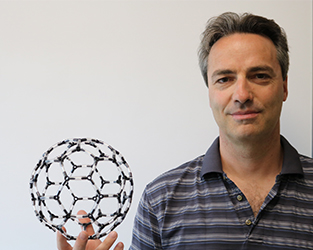Invisible Spheres Filling the Void of Space

Jan Cami with Buckyball Model
In 1985, three researchers by the names of Harry Kroto, Robert Curl and Richard Smalley set out to investigate the origins of carbon atom chains. The belief by one prominent astronomer at the time was that these chains were being formed in the barren, desolate backdrop of deep space, a cutthroat environment where these molecules were being sculpted into an incredibly stable form. Kroto sensed that this was inexact, and speculated that these carbon chains were actually forming around dying stars. His hypothesis was that once the star eventually faded, expelling its gassy outer layers in the process, the molecule was so stable that it was able to survive even the harshest conditions that deep space had to offer. To prove this, he devised a laboratory experiment aimed at simulating the chemistry occurring in the surroundings of dying stars, by using a laser to vaporize graphite – pure carbon dust. This process destroys the weaker molecules, leaving the strongest pieces of carbon. As they ran trial after trial, a particular carbon structure became increasingly prominent; a three dimensional, soccer-ball-shaped molecule made out of 60 carbon atoms. This 60-atom structure is the smallest possible size that can exist while fulfilling all chemical and geometrical requirements of a sphere. These specific carbon structures are known as buckyballs and are fondly referred to as an “island of stability”.
Jan Cami, a Belgian astronomer, and researcher from the Department of Physics and Astronomy at Western University was a starry-eyed teenager when Kroto and company embarked on their experiment at Rice. He remembers hearing about the Kroto project and being amazed.
“I was 13 when buckyballs were discovered on Earth. I remember reading Science articles about these soccer ball molecules made out of carbon, and thinking it was so compelling.”
Fast forward 33 years, and Jan is now one of the world’s foremost authorities on buckyballs. A field that has only grown in following since Kroto, Curl and Smalley were recognised for their discovery with a Nobel Prize for Chemistry in 1996, Jan has cemented himself as a rightful bearer of the buckyball torch after a trailblazing breakthrough in 2010.
“When I was a grad student, I was involved in a proposal to look for one specific fingerprint at infrared wavelengths. In 2010, we studied an unusual infrared observation with the Spitzer Space Telescope of a planetary nebula in the Southern constellation of Ara, six thousand light-years away. These Spitzer observations clearly contained the 60-atom buckyball signature. This was quite a revelation because the largest molecule we had found in space up to that point was 12–15 atoms. Our research culminated in the realization that they are quite abundant and wide-spread. These structures occupy a variety of different environments in space, and we see that half a percent or so of all the carbon in the universe comes from these molecules.”
Buckyballs represent a beautiful, astral spin-off of Darwin’s ‘Survival of the fittest’ concept.
“Their stability is evident from laboratory experiments on Earth. However, their abundancy in the harshest environments of space – where their occupancy is glaring, because of how few things can survive there reduces the “contamination” in our observations.”
Most molecules disintegrate from UV light in space, but buckyballs don’t — they absorb light, becoming charged with the excess energy in the process. This sounds weighty on the surface, but it doesn’t even accurately convey the revolutionary nature of this molecule. In space, the procedure of small pieces coming together to make something larger is so slow, that it would take longer than the age of the universe for these molecules to form. This rules out the antecedent blanket-rule that postulated celestial chemistry as an exclusively bottom-down (i.e. small things bridging to form a larger thing) mechanism. Buckyball’s provide concrete evidence that top-down chemistry can exist in nature, and indicates that it may play a sizeable role in the all-encompassing chemistry of outer space. Buckyball’s provide insight and a possible explanation for countless numbers of other identified molecules floating around in the universe.
Furthermore, the soccer ball-esque shape of the molecule allows for energy containment and the ability to compress when withstanding impact; a bend-but-don’t break mantra that two-dimensional structures are not afforded the luxury of. The concept that living things can form in space, in an alternative way to how life comes to be on Earth, is the type of idea that turns the cerebral wheels of Earth’s most ambitious researchers.
“If the processes that lead to life on Earth are a result of chemical nature, then the more we understand the chemistry in space, the more we will understand whether there are similar processes that have happened elsewhere.”
Jan’s telescopes have taken him a long way from home, but when you’re attempting to learn more about life in the vast, endless vacuum of the universe, which direction do you head in?
“We really want to understand the forming of these molecules. We see them appearing in only a small fraction of young planetary nebulae, but we do not see them in more mature planetary nebulae. Have they been destroyed? Or are they evolving into something else? Figuring out how they change and why they change will give us insight into how physics and chemistry interplay in those environments. What I’m most excited about is that we now have a direct way of comparing some of these unidentified interstellar molecular signatures that seem related to the carbon 60-atom structures. We hope to identify some of those species in the next few years.”

